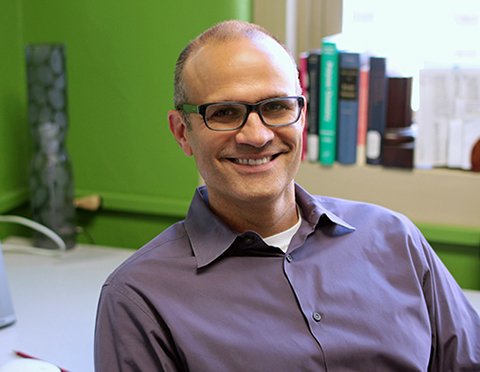Marc Hillmyer: Building a better plastic

Marc Hillmyer’s office is filled with eye-catching conversation pieces, from the bright green paint on his walls to the molecular models on his shelves. But his favorite piece is easy to overlook. It’s a small sampling of plastics, which he holds and stretches while explaining his current research.
“See, they’re just as stiff or flexible as the plastics that come from petroleum,” Hillmyer said, “but these all come from sugar.”
It’s true, you can’t tell the difference. While some bioplastics are no match for their petrochemical counterparts, Hillmyer’s samples are extremely durable. Yet, thanks to their highly oxygenated content, they will naturally break down over time.
“Some people respond to the word ‘plastic’ as if it's evil. But actually they're modern materials that, if used judiciously and sourced intelligently, can be a big benefit to society.”--Marc Hillmyer
There’s no denying that plastics have become a huge problem in our environment — in our bodies, landfills, oceans and beyond. They’re also central to our daily lives, from our cars and computers to our clothing. The fact is, they aren’t going anywhere anytime soon.
“Some people respond to the word ‘plastic’ as if it's evil,” Hillmyer said. “But actually they're modern materials that, if used judiciously and sourced intelligently, can be a big benefit to society.”
This next generation of plastics not only needs to be attractive to industry and consumers from a performance and cost standpoint. The plastics also need to be nontoxic, biodegradable, and recycled, composted, or incinerated by environmentally sound methods.
It’s a complex problem to solve, but the University of Minnesota’s Center for Sustainable Polymers is up for the challenge. As director of the center, Hillmyer has already watched several ideas and projects generated in the laboratory catch the attention and interest of industry, and these successes and technology transfers push him forward.
“I love basic research, but I’m also passionate about how what we do can translate to technological realities.”
Thanks to a recent $20 million grant from the National Science Foundation, the center has a significant edge in translating new materials to real-world uses. “Our goal with the new funding cycle is to really go for it,” Hillmyer said. “Let’s figure out how to revolutionize the polymer industry.”
Part of the Phase II Center for Chemical Innovation program, the grant represents one of the most significant investments in the history of the NSF’s Division of Chemistry. With the award, the Center for Sustainable Polymers will continue to bring together top researchers from the University of Minnesota, Cornell University, and the University of California, Berkeley, along with more than 30 companies from across the nation.
“We're going to push on the side of high-risk, high-reward research, while staying grounded in the economic realities of the industry,” Hillmyer said.
As an undergraduate in college, Hillmyer had initially planned on becoming a medical doctor. But after learning about general chemistry from an enthusiastic professor, he was inspired to dig deeper into the field.
Today, as a chemistry professor at the university, Hillmyer is paying it forward. “I’m enthusiastic about polymer science and I try to communicate that enthusiasm to my students. It’s more than just facts and figures. It's something that impacts our lives and our future.”
